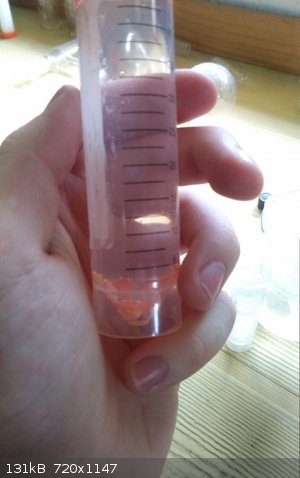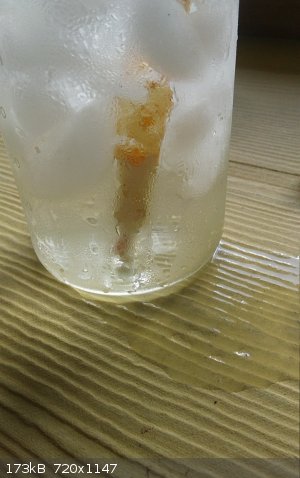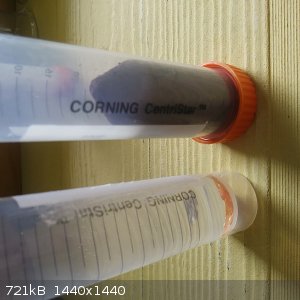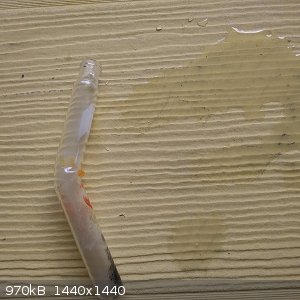VSEPR_VOID
National Hazard
   
Posts: 719
Registered: 1-9-2017
Member Is Offline
Mood: Fullerenes
|
|
Conversion of Red Phosphorus to Tetraphosphorus by the Action of Heat
Introduction
White phosphorus, tetraphosphorus, has the formula P4 and takes on a tetrahedral geometry. Compared to the more common allotrope, red amorphous
phosphorus, tetraphosphorus is far more unstable, reactive, and soft/waxy. This is due to the strain of the six P-P bond, and the reduced surface area
of the molecule for dispersion forces to cause cohesion. Tetraphosphorus has a density, when the most common form (α), of 1.828 grams per cubic
centimeter. It’s boiling point is 44.15 degrees celsius.
Tetraphosphorus is often employed as a reactant when elemental phosphorus is needed. It is used as a chemical weapon, in phosphorus munitions as an
incendiary, and in the production of nerve agents such as sarin and VX. For this reason the unregulated sale of red amorphous phosphorus and white
phosphorus is not prevented in both the United States and the European Union, though the legislation is not often successful.
Warning
The handling and manufacture of tetraphosphorus is extremely dangerous. Tetraphosphorus is extremely flammable, ignites in air (pyrophoric), is
extremely toxic, and emits oxides of phosphorus when burning. These fumes dissolve in the lungs of the unfortunate and produce phosphoric acid,
causing burns. Only attempt this if you are aware of the dangers and have adequate protection. Only attempt this in a ventilated area well wearing a
gas mask, equipped with suitable filters, a lab coat, gloves, and closed shoes. In addition a reliable pair of running shoes is recommended in case of
fire. The laboratory should also be equipped with a powder fire extinguisher. Tetraphosphorus causes extreme damage to the liver upon ingestion and
may cause phossy upon chronic exposure.
Overview
Tetraphosphorus is prepared by heating red amorphous phosphorus in an air free environment. The gaseous phosphorus is s condensed and stored under
water. If tetraphosphorus is heated to above 290 celsius to converts back to its red amorphous allotrope.
Materials
0.8 grams of red amorphous phosphorus
Test tube
600ml Beaker
Ice water
Propane torch
Apparatus
A retort was manufactured by bending a glass vial to approximately 30 degrees by means of a propane torch. The later half of the vessel was placed
into cold ice water.
Procedure
0.8 grams of 98.8% pure red phosphorus was placed into a simple retort as described in the section above. The retort was lowered into a 600ml
beaker of ice water and heated for four minutes with a propane torch. A pale-yellow front was observed migrating from the hot end of the apparatus to
the cool end. Small amounts of gaseous phosphorus occasionally escaped and rapidly combusted upon contact with air issuing a loud report that alarmed
the researcher. The reaction is finished when no more tetraphosphorus is observed forming in the cool end of the tube.
Once complete the tube was permitted to cool to room temperature. The tetraphosphorus was immediately removed from the reaction vessel using a wooden
skewer and placed into a conical tube containing water after being weighed briefly. A final mass of ~1 grams of wet yellow-pale red tetraphosphorus
was observed. The conical tube was wrapped in aluminium foil and stored in a aluminium can.
Discussion
I have 14g of red phosphorus remaining and would like to convert it to the white allotrope for future use as I have no use at the moment for the red
allotrope. I am interested in constructing a more reliable and reusable apparatus for this purpose and am considering incorporating a 200mm liebig
condenser into it. This would incorporate washing of the apparatus with carbon disulfide for collection and purification. In the future I may attempt
this using powderized ferrophosphorus (available for 5.40 dollars/kg: 26.36% phosphorus) instead of red phosphorus.
  
[Edited on 5-5-2018 by VSEPR_VOID]

Within cells interlinked
Within cells interlinked
Within cells interlinked
|
|
|
VSEPR_VOID
National Hazard
   
Posts: 719
Registered: 1-9-2017
Member Is Offline
Mood: Fullerenes
|
|
Addendum
I made another attempt and when heating the test tube shattered. Once cleaned up I found no damage had been done to the surface of the work bench or
the other glassware.
it is important that if the retort is made of glass it not be reused. It is also important to clean your work space well after preparing
tetraphosphorus as small bits of it may find its way onto your desk.
Within cells interlinked
Within cells interlinked
Within cells interlinked
|
|
|
njl
National Hazard
   
Posts: 609
Registered: 26-11-2019
Location: under the sycamore tree
Member Is Offline
Mood: ambivalent
|
|
Have you had any luck creating a reusable apparatus?
|
|
|
Tsjerk
International Hazard
    
Posts: 3022
Registered: 20-4-2005
Location: Netherlands
Member Is Offline
Mood: Mood
|
|
You could make a copper pipe with a screw cap and bend it like VESPER_VOID did with the glass tube.
|
|
|
teodor
National Hazard
   
Posts: 872
Registered: 28-6-2019
Location: Heerenveen
Member Is Offline
|
|
But I don't quite understand what exactly makes reuse of glass problematic in this process. Does P4 reacts with glass? Is there some specific thermal
degradation? Is it some action on glass in the process of cleaning? Is it dependent on type of glass (soda lime/borosilicate)? Does it dependent on
oxide formation (so, try to exclude O2)? So, it is not clear from the original report what could be wrong.
[Edited on 16-11-2020 by teodor]
|
|
|